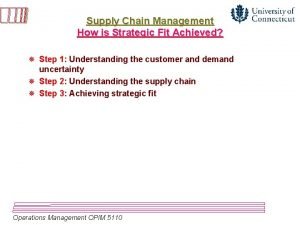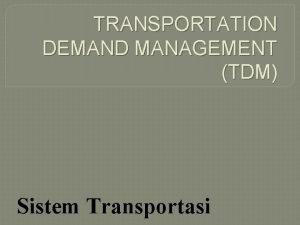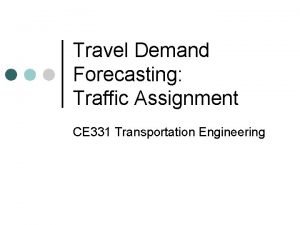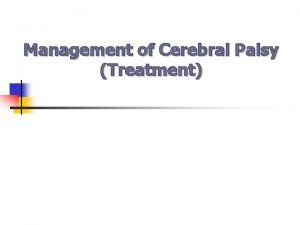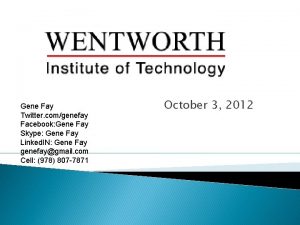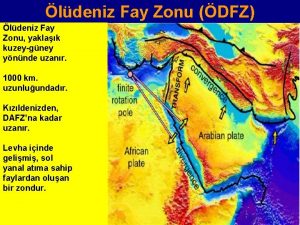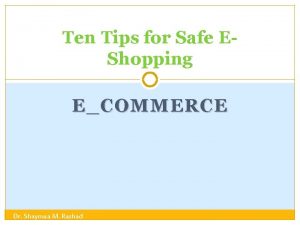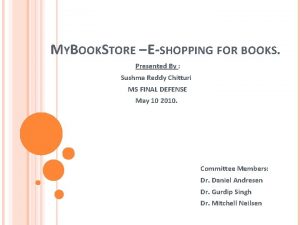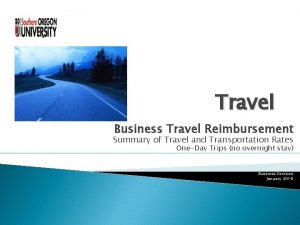Impact of Eshopping on travel demand Daniel Fay






















- Slides: 22

Impact of E-shopping on travel demand Daniel Fay, WSP Peter Vovsha, Gaurav Vyas, INRO Proprietary and Confidential ©INRO 2019 TPAC, Portland, OR, June 2 -5, 2019 1

Background motivation & hypothesis Proprietary and Confidential ©INRO 2019 TPAC, Portland, OR, June 2 -5, 2019 2

Background & motivation ● ● Modelling shopping behavior is important since shopping represents a substantial component of regional travel demand (≈10% of all trips) Over the past decade the adoption of E-shopping has significantly increased leading to considerable impacts on outof-home shopping Need for a reliable model which accurately captures this change in shopping behavior This analysis presents findings on the adoption and intensity of E-shopping and its impact on traditional onsite shopping TPAC, Portland, OR, June 2 -5, 2019 3

Plausible hypotheses ● ● E-shopping reduces conventional shopping trip rates? E-shopping reduces out-of-home shopping duration? E-shopping may generate more freight deliveries and person trips for returning purchases? All above might be differential by shopping types: ○ ○ Major shopping (clothes, furniture) Routine grocery shopping TPAC, Portland, OR, June 2 -5, 2019 4

Modeling issues related to shopping trips ● Common to an aggregate trip-based 4 -step model or tour-based Activity-Based Model (ABM): ○ ○ ● Trip frequency (trip generation) Choice of shopping destination (trip length distribution), Choice of mode Choice of time-of-day period Additional travel dimensions pertinent to ABM: ○ ○ ○ Intra-household allocation of shopping tasks to persons Placement of shopping activity in the individual activity pattern Joint vs. individual implementation of shopping tasks TPAC, Portland, OR, June 2 -5, 2019 5

Principal question ● ● ● Modeling issues of this type are resolved by using comprehensive Household Travel Surveys (HTS’s). The models are well calibrated to reproduce the observed patterns in HTS Principal question is how stable these parameters are over time and to what extent the shopping travel habits observed today will be relevant 20 -30 years from now While this question is fundamental to all travel purposes, it is especially crucial for shopping as the significant impact of Eshopping is already being observed and the future impacts may be even greater due to the very dynamic changes in mobility TPAC, Portland, OR, June 2 -5, 2019 6

Results of statistical analysis Proprietary and Confidential ©INRO 2019 TPAC, Portland, OR, June 2 -5, 2019 7

Data: 2 HTS’s for Columbus, OH Characteristic HTS 1999 HTS 2017 Collected data & technology All out-of-home activities and trips of all household members for one workday (24 hours) i. Phone app trace for 7 days of which one (primary) workday was chosen for a complete retrieval of all out-of-home activities and trips of all household members E-shopping activity during the week N/A Yes No Number of HHs 5, 555 1, 991 1, 032 Pure effect of Eshopping General time trend & survey technology impact TPAC, Portland, OR, June 2 -5, 2019 8

Focuses of analysis The analysis focused on 4 dimensions: ● Household-level frequency of shopping activities ● Intra-household allocation of shopping tasks and person shopping activity levels ● Shopping activity time allocation and epoch duration ● Shopping activity placement in the individual daily activitytravel patterns TPAC, Portland, OR, June 2 -5, 2019 9

Daily frequency of shopping activity per HH TPAC, Portland, OR, June 2 -5, 2019 10

Model estimation results for HH daily shopping activity frequency √ TPAC, Portland, OR, June 2 -5, 2019 11

Conclusions on HH shopping activity rates ● Pure effect of E-shopping: ○ ○ ○ ● HH with 3 or more members who reported E-shopping exhibited a tendency for a higher frequency of shopping epochs E-shopping duration negatively affects frequency of individual major shopping E-shopping duration positively affects frequency of joint major shopping Time trend: ○ ○ Observed HHs in 1999 performing more frequent shopping epochs than observed HHs in 2017 This is evident from analyzing both the proportion of HH shopping epoch frequency by HHs size as well as the coefficients of the estimated choice models TPAC, Portland, OR, June 2 -5, 2019 12

Average daily HH time for out-of-home shopping TPAC, Portland, OR, June 2 -5, 2019 13

Daily HH time allocation to out-of-home shopping by HH size TPAC, Portland, OR, June 2 -5, 2019 14

Average shopping epoch duration by HH shopping frequency TPAC, Portland, OR, June 2 -5, 2019 15

Conclusions on shopping time allocation and activity epoch duration ● Daily time allocated to out-of-home shopping tasks: ○ ○ ● Average epoch duration: ○ ● Online shopping for HH sizes ≤ 2 was found to have an inverse relationship, whereas HH that spend more time online shopping are more likely to allocate less time to out-of-home shopping However, HHs with size ≥ 3 did not illustrate any discernible pattern related to online shopping Very clear negative correlation between average daily online shopping time and the average epoch duration (expected effect of online shopping) Time trend: ○ More time on shopping over years (can be a survey technology effect) TPAC, Portland, OR, June 2 -5, 2019 16

Daily frequency of shopping activity person type TPAC, Portland, OR, June 2 -5, 2019 17

Conclusions on intra-household allocation of shopping tasks ● Full-time workers and university students who tend to have relatively rigid schedules: ○ ● Part-time workers who have a much more flexible schedule: ○ ● No strong impact of competition and online versus offline Highly impacted by both the presence of competition and online and offline HHs. Within HHs of only part time workers, ones who participate in online shopping make considerably more 1 and 2 daily shopping epochs as compared to the offline HHs Competition in the HH results in a substantial decrease in the frequency of shopping epochs: ○ ○ Other person types will typically perform the shopping epoch rather than the part-time workers in the HH Contrary to the initial hypothesis, non-workers and retirees also see a reduction in the frequency of shopping epochs when there is competition presence TPAC, Portland, OR, June 2 -5, 2019 18

Shopping activity placement in individual daily pattern TPAC, Portland, OR, June 2 -5, 2019 19

Conclusions on shopping activity placement in the individual daily activity pattern ● Workers: ○ ○ ● University students: ○ ● Tend to perform shopping epochs during a non-mandatory daily activity pattern Driving age and pre-driving age school children: ○ ● Most shopping epochs are performed on a tour within a non-mandatory pattern with the exception of full-time workers in 2017 who participate in 1 to 59 minutes of online shopping. Those perform the majority of their shopping epochs on the way home from a mandatory activity Full-time workers in 1999 HTS perform majority of their shopping epochs after a mandatory activity on a separate tour (stands out) Tend to perform shopping epochs on a separate tour after completing their mandatory activity Pre-school children: ○ Most likely to participate in shopping epoch during the time retirees and non-workers perform theirs and thus are most likely to perform a shopping epoch during a non-mandatory pattern. TPAC, Portland, OR, June 2 -5, 2019 20

Recommendations for travel modeling in practice ● Pure effect of E-shopping: ○ ○ ○ ● Overall, E-shopping does not affect household trip rates that much and trip generation rates applied in 4 -step models observed in the recent surveys can be applied for future forecasts However, finer effects that are captured in more advanced ABMs such as shopping epoch duration and daily time allocation to shopping can be affected by E-shopping The best way to accommodate E-shopping in a future forecast is to include it as a variable in the corresponding sub-models and then apply them assuming 100% of E-shopping penetration General trend after controlling for E-shopping: ○ ○ There can be a general time trend on a reduction of shopping frequency as was observed for Columbus, OH for the period from 1999 to 2017 It is always better to have a “younger” HTS for a model estimation It is possible to extrapolate this tendency into the future assuming that people will shop instore less Would be interesting to cross-compare different regions before making a generalization TPAC, Portland, OR, June 2 -5, 2019 21

Thank You! Peter Vovsha peter@inrosoftware. com Proprietary and Confidential ©INRO 2019 TPAC, Portland, OR, June 2 -5, 2019 22
 What is eshopping
What is eshopping Impact of customer needs on implied demand uncertainty
Impact of customer needs on implied demand uncertainty Air travel demand forecasting
Air travel demand forecasting Materi transportation
Materi transportation Travel demand forecasting
Travel demand forecasting Geçirimli kayaç fay hattı
Geçirimli kayaç fay hattı Ira fay
Ira fay Derek alton walcott
Derek alton walcott Ableist
Ableist Fay patel
Fay patel Phi sigma theta
Phi sigma theta Test de fay
Test de fay Fay flowers for algernon
Fay flowers for algernon Fay chang google
Fay chang google Fay godwin biography
Fay godwin biography Temple fay method
Temple fay method Sidney bradshaw fay thesis
Sidney bradshaw fay thesis Fay godwin landscape
Fay godwin landscape Charissa fay
Charissa fay Fay
Fay Gene fay
Gene fay Fay chang google
Fay chang google Marmara denizi fay hattı
Marmara denizi fay hattı

